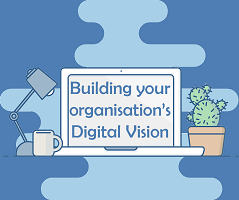The last twelve months saw many professional bodies’ attentions shift from growth to survival. With the end of the pandemic now in sight, associations should now revert to their digital transformation journeys to ensure longevity and improve their membership retention efforts.
Building your digital vision
Technology played a pivotal role in strengthening our resolve during the struggles that come with the pandemic. However, like many, you may have identified cracks in your current digital infrastructure.
Half of business executives surveyed by McKinsey said they didn’t implement technology changes before the Covid crisis because it wasn’t a top business priority.
This was when the consequences truly hit home.
According to a Gartner survey, more than half (55%) respondents said they used personal devices for work purposes.
Whit Andrews, Vice-President at Gartner, said: “When organisations were forced to go remote in early 2020, workers started to rely on their own devices for programs they discovered themselves to make up for their employers’ technology shortcomings. In 2021, organisations can embrace this trend by expanding the choice of devices and software programs that workers can use with little or no friction.”
What’s a Digital Vision?
A digital vision is not a mission statement. You are not stating who you are and why you exist as an organisation.
A digital vision is forward-thinking and defines “who we want to become” as an organisation through emerging technologies.
You’re answering important questions, such as what problems will we solve for our members, how our members will interact with our products and services, and what our people, their skills, and our overall organisation will look like.
Your digital vision should paint a compelling picture for the transformation, and it should foster understanding at all levels of the organisation. This will empower your teams to help you successfully create the new reality you envision.
One thing NOT to miss
For us, the number one rule of digital transformation: focus on members, not technology.
Your association’s digital vision shouldn’t be about getting as much technology in front of your members as possible; it’s about analysing what technologies your members will benefit from.
You should base it on a strong knowledge of your members, the problems they face and how the latest technologies can overcome these.
Losing sight of your members and how you can improve their experiences with your association lies a sure-fire way of not delivering value, and potentially weakening their engagement levels.
How do you implement it?
Nigel Fenwick from Forrester provides great advice on planning and implementing a digital vision. He identified three main areas.
- “Illustrate what customers will value in the future”.
- “Show how your relationship with the customer will change”.
- “Make your vision dynamic enough to change customer expectations”.
How your members gain value from their membership won’t be the same in the future as it is today. Technology is always changing, so too is your members’ use and expectation of the technology you provide.
Brand reputation is one of the main deciding factors when members choose whether to engage with your organisation. Member’s perception of value will be shaped by the digital experiences you offer as part of their membership.
As I touched on before, don’t mistake this for needing to get the latest technology in front of your members. Delivering technology comes at a cost, therefore it needs to deliver value to you and your members.
How to identify what adds value to your members?
Previously, I spoke about developing Key Member Personas and creating User Journeys to help boost your retention rates.
These are perfect starting points to begin developing your digital vision. When creating your Key Member Personas, can you find any areas of their professional life – or your membership – they are missing or needs improving?
For example, a professional could have become a member to improve their chances of finding work once they’re qualified.
What technologies could you use to improve network and job prospecting across your members?
Map out their core tasks and what they do to achieve these, as well as the journey they take when engaging with your membership.
Engage the organisation
The success of your digital vision project is heavily dependent on the people involved – focusing on the people element is critical to achieving your digital transformation goals.
But how do you get them to engage with the new technology and widespread change?
- Communication
According to research by McKinsey, businesses with senior leaders who communicate with employees at all levels are eight times more likely to achieve success with transformation. As well as getting staff on board, continuous communications helps prevent your staff from going back to old ways.
- Education
It’s important for everyone in the organisation to understand how the new processes will help improve their roles. Part of your communication plan should focus on education- don’t just explain what you’re doing; explain why you’re doing it for them.
- Feedback
Communication works both ways. As well as your colleagues listening to you, you need to listen to them. Their day-to-day insights will be invaluable as you develop your digital vision, so actively encourage feedback (and participation) from all levels.
Particularly in the early stages, it’s important to continually review and test for snags and improvements.
 PSP-IT is an award-winning IT service provider who has worked with large membership associations. Our work includes bespoke website development, software application development and Membership CRM development.
PSP-IT is an award-winning IT service provider who has worked with large membership associations. Our work includes bespoke website development, software application development and Membership CRM development.
Speak to our team of experts: 01775 722377.









Leave A Comment